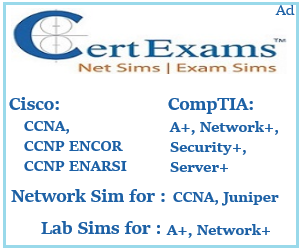3.6.2 Financial Management
for IT services
A) Purpose of Financial Management Process
-
1) Secure the appropriate level of funding to design,
develop and deliver services that meet the strategy
of the organization.
-
2) Act as a gatekeeper that ensures that the service
provider does not commit to services that they are not
able to provide.
-
3) Identify the balance between the cost and quality
of service and maintain the balance of supply and demand
between the service provider and their customers
B) The Objectives of Financial Management Process
-
1) Reduce long term costs - empower management.
-
2) Declares Added Value of IT.
-
3) Improved Total cost of ownership and return on investment.
-
4) Forces business to make service levels and their costs
more visible.
-
5) Assures senior management/stakeholders that IT is
well managed and meeting business needs.
-
6) Assists change management processes.
C) Scope of Financial Management Process
Ensures the financial practices within IT is consistent with
organizational standards so that other business units will have
an understanding of how IT is funded
D) Activities of Financial Management
-
1) Budgeting: is the predicting the expected future requirements
for funds to deliver the agreed upon IT services to the
service customers. Budgets are typically created on an annual
basis. The activity requires careful monitoring of agreed
budgets against the actual spend (accounting).
-
2) Accounting: enables the IT organization to account
fully for the way its money is spent (the practices allow
identification of costs by customer, service and/or activity).
The activity is not simple and this is one area that should
involve some outside expertise usually provided from within
the Finance Department.
-
3) Charging: is an optional activity within financial
management for IT services. The decision whether the IT
department will charge customers for the actual provision
of IT services is made at a strategic level - not from within
the IT department. Charging must be linked to controllable
aspects for customers/users as they may wish to alter their
behavior/usage of services based on the charges they incur.
E) Business Case
-
1) A business case is the justification for a significant
item of expenditure. The business case includes information
about costs, benefits, options, issues, risks and possible
problems.
-
2) A business case is a tool for decision planning and
support for understanding the likely consequences of a business
decision in quantitative or qualitative terms.
-
3) Information can be captured from the Service Portfolio
with sound financial management.
-
4) Business cases are built in Business Relationship
Management process and evaluated in Service Portfolio Management
process.
-
5) Example for business case structure is as follows:
-
a) Introduction - business objectives addressed.
-
b) Methods and assumptions - boundaries of the business
case.
-
c) Business impacts - financial, non-financial results
anticipated.
-
d) Risks and contingencies - probability that alternative
results will emerge.
-
e) Recommendations - specific actions recommended.
3.6.3 Business Relationship
Management Process (BRM)
Business Relationship Management is a process responsible
for maintaining a positive relationship with customers. BRM
identifies customer needs and ensures that the service provider
is able to meet these needs with an appropriate catalogue of
services. This process has strong links with service level management.
A) Purpose of Business Relationship Management Process
The purpose of BRM is to establish relationship between
the service provider and customers and to ensure customers
satisfaction by responding to changing requirements and
managing customer expectation.
B) Objectives of Business Relationship Management Process
1) Understand customers needs and prioritize services
accordingly to meet user requirements
2) Maintain good communication.
3) Handle conflicts and complaints effectively
4) Identify changes in business environment and technology
that could impact services
5) Ensure customer satisfaction.
C) Scope of Business Relationship Management Process
-
1) BRM focuses on understanding how services meet customer
requirements.
-
2) Business outcomes that the customer wants to achieve
-
3) Services currently offered to the customer, and how
they are used by the customer
-
4) How services are currently offered including who is
responsible for them, agreed
-
5) levels of service, quality of services delivered and
any changes that are anticipated
-
6) Technology trends that could impact current services
and the customer, and how
-
7) Levels of customer satisfaction; action plans in place
to deal with the causes
-
8) How to optimize services for the future
-
9) How the service provider is represented to the customer
4. Service Design
4.1 Purpose of Service Design
-
1) The purpose of Service Design is to deliver a new
service / service amendment that can deliver the strategic
outcome required the design of both the services and the
service management processes need to be included.
-
2) Need to ensure the service will run within budget
and meet/exceed customer requirements.
4.2 Objectives of Service Design
-
An objective of Service Design stage of ITIL service
life cycle is to design Services that can be easily and
efficiently developed and enhanced.
4.3 Scope of Service Design
-
1) Consider not only the current requirements but also
future needs (e.g. take advantage of technical advancements,
can be easily adapted to future needs)
-
2) Describes how to identify requirements (functional
and service level) and ensure the delivery of such requirements
4.4 Value to Business
-
1) Ensuring that services are aligned with business objectives
-
2) Ensuring that services are able to provide the utility
and warranty required for them to meet the objectives outlined
during Service Strategy.
-
3) Ensuring that service management systems and tools
are capable of supporting service offerings
-
4) Ensuring that service-e management processes are capable
of supporting service offerings
-
5) Ensuring that services are constructed according to
agreed architectural standards
-
6) Ensuring that services are designed so as to be implemented
efficiently
-
7) Ensuring that services are designed so that their
performance can be measured
4.5 Four P's of Service Design
A Service Designer need to consider the following "Four P's
of Service Design" while designing a service. The Four P's are
as follows:
-
1) People: Human resources and organizational structures
required to support the service
-
2) Processes: Service Management Processes required to
support the service
-
3) Products: The products are the tools, services, and
technology used in the delivery of, and support of, the
services.
-
4) Partners: When designing services, vendors, manufacturers,
and suppliers should be considered as they will be utilized
to support the service once it is live.
4.6 Five major Design aspects of Service
Design
The 'Five Aspects of Service Design' are areas which should
also receive design focus as part of the overall effort design
a service. The areas include:
-
1) Service solutions: Include all of the functional requirements,
resources and capabilities needed and agreed upon
-
2) Service Management systems and tools: these are used
to support and automate processes (e.g. quality management
system, information security system). To ensure consistency
with other services and guarantee that supporting and dependent
services are adequate to maintain on-going reliable service
delivery
-
3) Technology architectures and management systems: To
ensure they are consistent with the new service and are
suitable to operate and maintain it.
Architecture is defined as the fundamental organization
of a system, embodied in its components, their relationships
to each other and to the environment, and the principles
guiding its design and evolution.
-
4) Processes: To ensure that the process, roles and responsibilities
are adequate to operate, support and maintain the new or
changed service
-
5) Measurement methods and metrics: To ensure that the
methods can provide the required metrics on the service.
4.7 Basic Concepts in Service Design
Processes
-
1) Service catalogue: A service catalogue is a database
or structured document with information about all live IT
services, including those available for deployment. The
service catalogue is part of the service portfolio and contains
information about two types of IT service: customer-facing
services that are visible to the business and supporting
services required by the service provider to deliver customer-facing
services.
The service catalogue has different views for different
people (users, IT, etc.)
-
a) Two-view (business service/technical service)
-
b) Three-view (wholesale customer, retail customer
and supporting services).
-
2) Service level agreement (SLA): SLA is a written agreement
between the Service Provider and a customer containing mutual
goals and responsibilities.
-
3) Operational level agreement (OLA): An Operational
Level Agreement (OLA) is an agreement between an IT service
provider and another part of the same organization. An OLA
defines the goods or services to be provided from one department
to the other, and the responsibilities of both parties.
-
4) Underpinning contract: An Underpinning Contract (UC)
is a contract with a third party, in support of the delivery
of an agreed IT service to a customer. The UC defines targets
and responsibilities that are required to meet agreed service
level targets in an SLA.
-
5) Service design package: The Service Design Package
(SDP) that was created in the Service Design phase contains
all aspects of an IT service and its requirements through
each stage of its lifecycle. It includes the information
about the execution of activities of the Service Transition
team.
-
6) Availability: The ability of a service, component
or CI to perform its agreed function when required.
Availability is measured and reported as a percentage.





